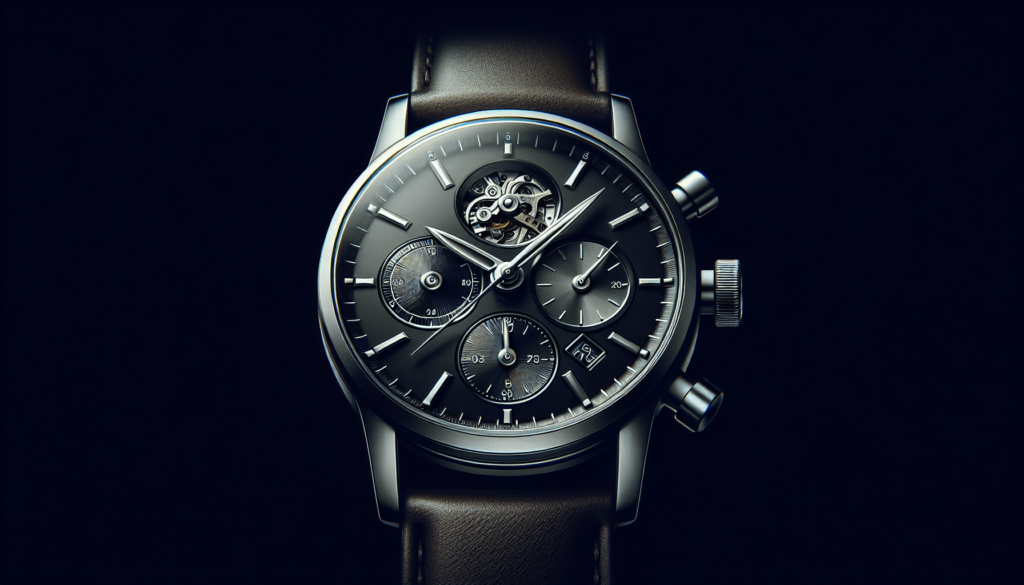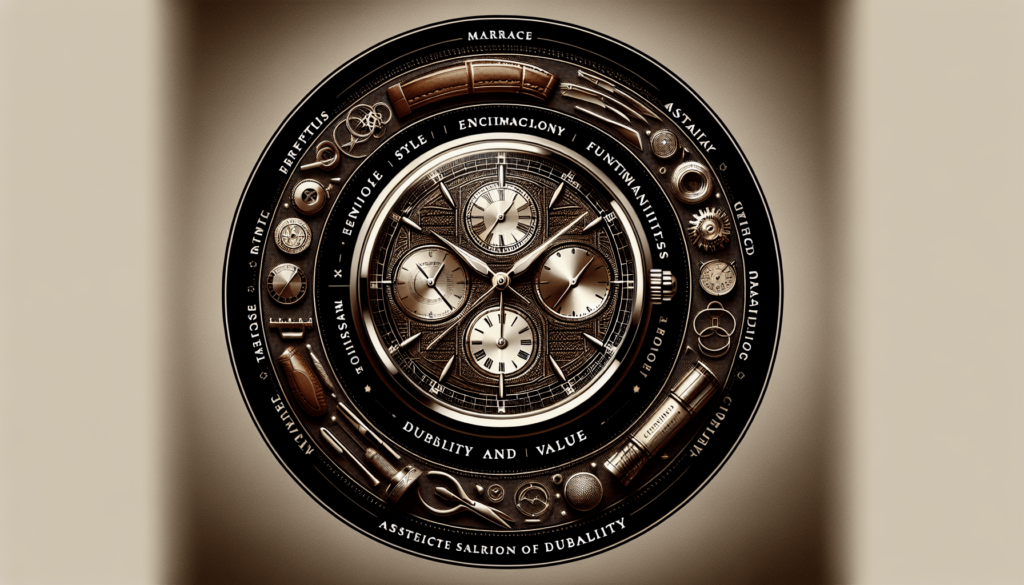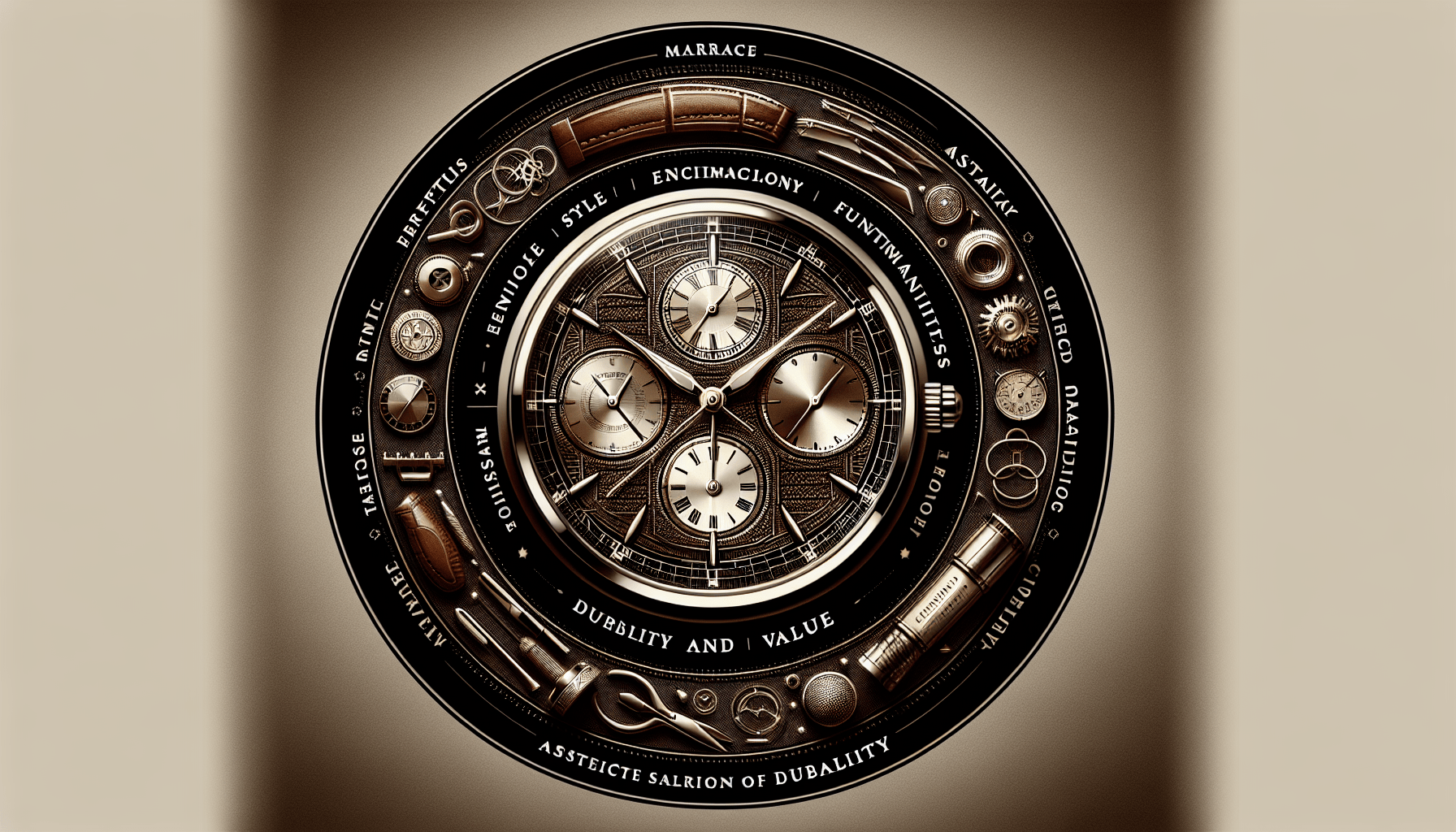So, you’re in the market for a new men’s wristwatch, but you’re not quite sure where to start. Look no further! In this article, we will discuss the key factors that you need to consider when making your purchase. From style and design to functionality and durability, we’ve got you covered. Whether you’re a seasoned watch collector or a first-time buyer, this guide will provide you with the essential information you need to make an informed decision. So, let’s dive in and find the perfect wristwatch for you.
Style
Analog or digital
When choosing a men’s wrist watch, one of the first decisions you’ll need to make is whether you prefer an analog or digital watch. Analog watches have a classic and timeless appeal, with their traditional hour and minute hands. They offer a more sophisticated and elegant look, making them suitable for formal occasions or as dress watches. On the other hand, digital watches display time in a numerical format and often come with additional features like chronographs, alarms, and timers. They are more casual and sporty in appearance, making them ideal for active individuals or those who prefer a more modern and technical aesthetic.
Dress watch or sports watch
Another important consideration is the intended use of the watch. Do you need a dress watch that adds a touch of elegance to your formal attire? Or are you in need of a sports watch that can withstand the rigors of your active lifestyle? Dress watches typically have a sleek and slim design, with a focus on elegance and simplicity. They are often made of precious metals like gold or silver and come with leather straps. Sports watches, on the other hand, are built to endure physical activities and are usually equipped with features such as water resistance, shock resistance, and rugged construction.
Case material
The case material of a watch plays a significant role in its overall appearance and durability. Common materials used for watch cases include stainless steel, titanium, ceramic, and even precious metals like gold or platinum. Stainless steel is a popular choice for its strength and affordability. Titanium is known for being lightweight yet highly durable, making it a preferred material for sports watches. Ceramic is highly scratch-resistant and offers a modern and sleek look. Precious metals like gold or platinum are often used in luxury watches, providing a luxurious and prestigious feel but at a higher price point. Consider the aesthetic appeal, durability, and budget when selecting the case material of your wrist watch.
Strap material
The strap material of a watch contributes to its overall style and comfort. Leather straps are a classic choice that exudes elegance and sophistication. They are comfortable to wear and can be easily dressed up or down depending on the occasion. Stainless steel bracelets offer a more polished and contemporary look, and they are highly durable. Rubber or silicone straps are commonly found in sports watches, as they are water-resistant and provide a comfortable fit during physical activities. The choice of strap material depends on your personal style, intended use, and comfort preferences.
Movement
Mechanical movement
Mechanical movement, also known as manual or hand-wound movement, is the traditional way of powering a watch. These watches require winding by hand at regular intervals to keep them running. Mechanical watches are often favored for their craftsmanship, intricate movements, and the ability to appreciate the artistry involved. They are also known to last for generations if properly maintained. However, mechanical watches tend to be more expensive and may require regular servicing to ensure accurate timekeeping.
Automatic movement
Automatic movement, also known as self-winding movement, relies on the motion of the wearer’s wrist to keep the watch running. The movement of the wrist winds a mainspring, which then powers the watch. Automatic watches are highly convenient as they eliminate the need for manual winding. They are often seen as a combination of traditional craftsmanship and modern technology. As with mechanical watches, automatic watches require regular servicing to maintain accuracy and functionality.
Quartz movement
Quartz movement is known for its accuracy and affordability. These watches are powered by a battery that sends electrical signals through a quartz crystal to keep time. Quartz watches are widely available and offer excellent timekeeping precision. They are low-maintenance and typically do not require regular servicing. However, quartz movement watches are often seen as less prestigious compared to mechanical or automatic watches due to their battery-operated nature.

Functionality
Timekeeping accuracy
Accurate timekeeping is an essential feature of any wrist watch. While mechanical and automatic watches can be highly precise, quartz watches are renowned for their superior accuracy, often only losing or gaining a few seconds per month. If you require a watch with precise timekeeping, especially for professional or business purposes, a quartz movement may be the most reliable choice. However, if you appreciate the craftsmanship and mechanics of mechanical or automatic watches, you may prioritize the charm and uniqueness they offer over slight deviations in timekeeping.
Additional features
Consider whether you require any additional features in your wrist watch. Many modern watches come with a range of functions beyond timekeeping, including chronographs, alarms, calendars, and world time zones. Sports watches often incorporate features such as timers, built-in compasses, or GPS capabilities. Think about your lifestyle and specific needs to determine which additional features would be useful and desirable.
Water resistance
Water resistance is an essential factor to consider, especially if you lead an active lifestyle or plan to wear your watch in water-related activities. Different watches offer varying degrees of water resistance, indicated by a depth rating in meters. It’s important to understand the water resistance capabilities of a watch to ensure it can withstand the activities you intend to engage in. Keep in mind that water resistance ratings can vary greatly, from basic splash resistance to diving capabilities. Choose a watch with a water resistance rating appropriate for your needs.
Brand and Reputation
Well-known brands
Purchasing a wrist watch from a well-known brand often comes with a sense of assurance and reliability. Established watch brands like Rolex, Omega, Tag Heuer, and Breitling have stood the test of time and are renowned for their craftsmanship, quality, and precision. These brands have built reputations for producing exceptional timepieces backed by years of experience and expertise. While prestigious brands often come with a higher price tag, you can have confidence in the reputation and long-standing history of these well-established watchmakers.
Brand reputation
In addition to the brand’s popularity and recognition, it is important to consider the overall reputation of the brand. Research the brand’s history, customer reviews, and their commitment to craftsmanship, quality, and customer satisfaction. A strong reputation signifies that the brand consistently delivers on their promises and provides reliable and durable watches. Take the time to read reviews, learn about the brand’s values, and ensure the brand aligns with your expectations and requirements.
After-sales service
Another aspect to consider, particularly for higher-end watches, is the brand’s after-sales service. A reputable brand should provide excellent customer service, including warranty coverage, servicing, and repairs. Explore the brand’s warranty policy, service center locations, and customer testimonials to assess their commitment to customer satisfaction. Choose a brand that offers reliable after-sales support to ensure your watch is well-maintained and protected in the long run.

Size and Fit
Case diameter
The size of the watch case is an important factor to consider, as it affects both comfort and style. The case diameter refers to the width of the watch case across the dial, measured in millimeters. Men’s watches generally range from around 38mm to 46mm, with larger cases being more popular in recent years. It’s essential to take into account your wrist size and personal preference when choosing the appropriate case diameter. A watch that is too small or too large may feel uncomfortable and look disproportionate, so it’s important to find the right balance that suits your wrist and style.
Case thickness
In addition to the case diameter, the thickness of the watch case should also be considered. A thicker case can give the watch a more substantial and robust appearance, while a thinner case can provide a sleek and elegant look. Thicker cases may be more suitable for casual or sports watches, while thinner cases are often preferred in dress watches. Ultimately, the choice of case thickness depends on your personal style and comfort preferences.
Strap length
The strap length is crucial for ensuring a comfortable fit. Most watches come with adjustable straps that can be resized to fit various wrist sizes. However, if you have a larger or smaller wrist, it’s important to check the strap length to ensure it will accommodate your needs. Some watches offer longer or shorter strap options, or you may need to purchase additional links or a different strap altogether to achieve the desired fit. Consider your wrist size and the adjustability of the strap when selecting a watch.
Budget
Setting a budget
Before diving into the world of men’s wrist watches, it’s important to establish a budget. Setting a budget helps narrow down the options and prevent overspending. Determine a comfortable spending range based on your financial capabilities and the value you place on a wrist watch. Consider any additional costs, such as after-sales servicing or strap replacements, when setting your budget. With a defined budget in mind, you can focus on finding a timepiece that meets both your desires and financial limitations.
Considering value for money
While it’s essential to set a budget, it’s also important to consider the value for money when purchasing a wrist watch. Instead of solely focusing on the price tag, analyze the overall quality, craftsmanship, and features the watch offers. Assess whether the watch justifies its price based on the materials used, brand reputation, and the functionality it provides. Remember that a higher price doesn’t always guarantee superior quality, so strive to strike a balance between affordability and value.
Durability and Quality
Materials used
The materials used in the construction of a watch greatly influence its durability and quality. Higher-grade materials tend to be more resilient to scratches, impacts, and daily wear. For example, stainless steel is highly durable and resistant to corrosion, while titanium combines strength and lightweight characteristics. Consider the overall build quality, including the case, bezel, crystal, and strap, to ensure the watch is made from durable materials that can endure your intended usage.
Build quality
Apart from the materials, the overall build quality of a watch contributes to its durability and longevity. Look for watches with solid construction, precise engineering, and attention to detail. Check the alignment of the dial, the smoothness of the crown, and the overall fit and finish. A well-crafted watch is less likely to develop mechanical issues or cosmetic flaws over time, ensuring years of reliable use.
Warranty
A warranty is an important aspect to consider when purchasing a wrist watch. It provides peace of mind and protects your investment in case of manufacturing defects or issues that arise shortly after purchase. Consider the duration and terms of the warranty offered by the brand. A longer warranty period typically signifies the brand’s confidence in their product’s quality. Additionally, find out if the warranty covers both parts and labor, or if there are any limitations or exclusions that may affect its validity.
Watch Face and Display
Dial design
The dial design of a watch is a key element that contributes to its overall aesthetics and legibility. There are various dial designs available, ranging from minimalistic and clean to intricate and elaborate. Classic designs often feature a simple and uncluttered dial with hour markers and either Roman or Arabic numerals. On the other hand, modern designs may incorporate a combination of indices, sub-dials, or skeletonized elements. Choose a dial design that aligns with your personal style and provides clear and easy-to-read timekeeping.
Watch hands
The design of the watch hands is an important consideration, as it affects the legibility and visual appeal of the timepiece. There are several types of watch hands, including baton, sword, dauphine, and skeletonized hands. Each style offers a unique look and can significantly impact the overall design of the watch. Consider the size, shape, and finishing of the watch hands to ensure they complement the dial design and provide easy time reading.
Display type
The display type refers to how the watch presents information. The most common display types are analog and digital. Analog displays use traditional hour and minute hands to indicate the time, while digital displays present time in numerical format. Within analog displays, there are also variations such as Roman numerals, Arabic numerals, or a combination of both. The choice between analog and digital displays comes down to personal preference and the style you find most appealing and readable.
Personal Style and Preference
Colors and finishes
Consider the colors and finishes that resonate with your personal style and complement your wardrobe. Traditional colors like silver, gold, or black provide a timeless and versatile look that pairs well with various outfits. If you prefer a bolder statement, you can explore watches with colorful dials or straps. Additionally, consider the finishes of the watch, such as polished, brushed, or matte, to find a style that suits your aesthetic preferences.
Design details
Pay attention to the design details that make a watch unique and visually appealing to you. This could include features like a textured or patterned dial, a distinctive bezel shape or color, or an intricately engraved case back. The design details add character and personality to the watch, allowing it to reflect your individuality and enhance your personal style.
Finding a watch that matches your style
Ultimately, finding a watch that matches your style is about considering all the elements discussed above and finding a balance that aligns with your preferences. Whether you prefer a classic and understated look or a bold and modern aesthetic, there is a wide range of options available. Take the time to explore different styles, try on watches in person if possible, and consider how the watch will fit into your existing wardrobe. A watch that resonates with your personal style will not only be a functional timepiece but also a statement accessory that complements your overall appearance.
Watch Maintenance
Regular servicing
To ensure the longevity and optimal performance of your watch, regular servicing is necessary. Mechanical and automatic watches, in particular, require periodic maintenance to keep them running accurately. It is recommended to have mechanical and automatic watches serviced every three to five years. Quartz watches typically require less frequent servicing but may still benefit from occasional maintenance to ensure longevity. Regular servicing includes cleaning, oiling, and regulating the movement, as well as inspecting and replacing any worn-out parts. Consider the availability of authorized service centers for the brand you choose to ensure easy access to professional servicing.
Availability of spare parts
When selecting a watch, it’s important to consider the availability of spare parts, especially for mechanical or automatic watches. Over time, certain components may require replacement due to natural wear and tear. Choosing a watch from a reputable brand with a strong after-sales service network ensures that genuine spare parts will be readily available when needed. This helps ensure the longevity and maintainability of your timepiece, even years after the initial purchase.
Ease of maintenance
Consider the ease of maintenance when choosing a watch. Some watches may have intricate movements or designs that require special tools and expertise for servicing. If you prefer a watch that can be easily maintained or serviced by yourself or local watchmakers, opt for simpler designs with readily accessible parts. On the other hand, if you are willing to take the time and effort to care for and maintain a more complex watch, you can enjoy the experience and satisfaction of being involved in its upkeep.

